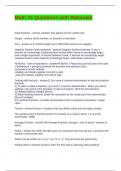Exam (elaborations)
Math #2 Questions with Rationale
- Course
- Institution
Math #2 Questions with Rationale Real Numbers numbers that appear on the number line. Integer whole number; no fractions or decimals Zero is an EVEN integer but is NEITHER positive nor negative Negative fractions and exponents Negative fractions between 0 and -1 become an ...
[Show more]



